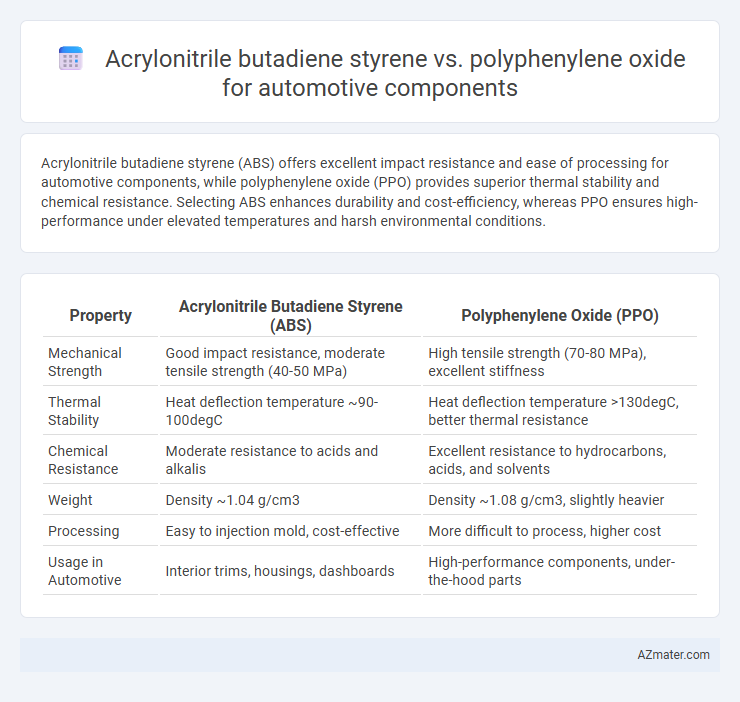Acrylonitrile butadiene styrene (ABS) offers excellent impact resistance and ease of processing for automotive components, while polyphenylene oxide (PPO) provides superior thermal stability and chemical resistance. Selecting ABS enhances durability and cost-efficiency, whereas PPO ensures high-performance under elevated temperatures and harsh environmental conditions.
Table of Comparison
| Property | Acrylonitrile Butadiene Styrene (ABS) | Polyphenylene Oxide (PPO) |
|---|---|---|
| Mechanical Strength | Good impact resistance, moderate tensile strength (40-50 MPa) | High tensile strength (70-80 MPa), excellent stiffness |
| Thermal Stability | Heat deflection temperature ~90-100degC | Heat deflection temperature >130degC, better thermal resistance |
| Chemical Resistance | Moderate resistance to acids and alkalis | Excellent resistance to hydrocarbons, acids, and solvents |
| Weight | Density ~1.04 g/cm3 | Density ~1.08 g/cm3, slightly heavier |
| Processing | Easy to injection mold, cost-effective | More difficult to process, higher cost |
| Usage in Automotive | Interior trims, housings, dashboards | High-performance components, under-the-hood parts |
Introduction to ABS and PPO in Automotive Applications
Acrylonitrile butadiene styrene (ABS) offers excellent impact resistance, dimensional stability, and ease of processing, making it a preferred choice for automotive interior components such as dashboards, trim, and enclosures. Polyphenylene oxide (PPO) provides superior thermal stability, chemical resistance, and electrical insulation, which are critical for under-the-hood applications and electronic housings. Both materials contribute to lightweight, durable vehicle parts that meet stringent automotive performance and safety standards.
Chemical Structure and Material Properties Comparison
Acrylonitrile butadiene styrene (ABS) features a copolymer structure combining acrylonitrile, butadiene, and styrene, offering high impact resistance, good toughness, and ease of processing, making it suitable for automotive interior components. Polyphenylene oxide (PPO) exhibits a rigid aromatic polymer structure with superior dimensional stability, heat resistance up to 190degC, and excellent electrical insulating properties, preferred for under-the-hood parts and electrical housings. ABS generally provides better impact strength and cost efficiency, while PPO delivers enhanced thermal stability and chemical resistance necessary for long-term automotive reliability.
Mechanical Strength: ABS vs. PPO
Acrylonitrile butadiene styrene (ABS) exhibits excellent impact resistance and toughness, making it suitable for automotive components requiring durability under dynamic stress. Polyphenylene oxide (PPO) offers superior mechanical strength with higher tensile and flexural modulus, providing enhanced rigidity and dimensional stability in high-temperature environments. Selecting between ABS and PPO hinges on balancing impact resistance and stiffness to meet specific automotive performance criteria.
Thermal Stability and Heat Resistance Analysis
Acrylonitrile butadiene styrene (ABS) offers moderate thermal stability with a heat deflection temperature typically around 90-100degC, making it suitable for automotive components subjected to mild heat exposure. Polyphenylene oxide (PPO) exhibits superior thermal stability and heat resistance, with heat deflection temperatures exceeding 140degC, ensuring enhanced performance in high-temperature automotive environments. The higher glass transition temperature and molecular structure of PPO contribute to its better dimensional stability and prolonged lifespan under thermal stress compared to ABS.
Impact Resistance and Durability in Automotive Components
Acrylonitrile butadiene styrene (ABS) offers superior impact resistance due to its rubber content, making it ideal for automotive components subjected to mechanical stress and sudden shocks. Polyphenylene oxide (PPO) provides excellent dimensional stability and chemical resistance, enhancing durability under high temperature and corrosive environments in automotive applications. Combining PPO with ABS often results in a material that balances high impact resistance and improved thermal and chemical durability, optimizing performance for automotive component manufacturing.
Chemical Resistance and Environmental Compatibility
Acrylonitrile butadiene styrene (ABS) exhibits moderate chemical resistance, particularly against acids and alkalis, but may degrade when exposed to strong solvents, impacting its durability in automotive components. Polyphenylene oxide (PPO) offers superior chemical resistance, maintaining stability against fuels, oils, and various automotive fluids, enhancing its longevity and performance in demanding environments. PPO also demonstrates better environmental compatibility due to its higher thermal stability and ability to withstand harsh automotive conditions, making it a preferred choice for components requiring long-term chemical and environmental resilience.
Weight Considerations in Vehicle Design
Acrylonitrile butadiene styrene (ABS) offers a balance of impact resistance and lightweight properties essential for automotive components requiring durability without excessive weight. Polyphenylene oxide (PPO) provides superior thermal stability and dimensional stability while maintaining low density, which helps reduce overall vehicle weight and improve fuel efficiency. Weight considerations in vehicle design prioritize materials like ABS and PPO to optimize performance, safety, and energy consumption through lightweight construction.
Processability and Manufacturing Flexibility
Acrylonitrile butadiene styrene (ABS) offers superior processability with lower melting temperatures and enhanced impact resistance, enabling efficient injection molding and faster cycle times in automotive component manufacturing. Polyphenylene oxide (PPO) provides higher dimensional stability and thermal resistance but requires more precise temperature control and slower processing speeds, which can limit manufacturing flexibility. ABS is preferred for complex geometries and rapid prototyping, while PPO is suited for high-performance parts demanding greater chemical resistance and structural integrity.
Cost Efficiency and Economic Impact
Acrylonitrile butadiene styrene (ABS) offers superior cost efficiency for automotive components due to its lower raw material and processing costs compared to polyphenylene oxide (PPO). PPO provides enhanced thermal stability and chemical resistance but at a significantly higher price, impacting overall production budgets and economic feasibility. Manufacturers prioritize ABS for large-scale automotive applications to optimize cost savings while maintaining adequate performance standards.
Application Case Studies: ABS vs. PPO in Automotive Parts
ABS exhibits superior impact resistance and dimensional stability, making it ideal for automotive interior components such as dashboards and trim panels that require durability and aesthetic appeal. PPO offers excellent thermal stability and chemical resistance, suitable for under-the-hood applications like air intake manifolds and electronic housing where high heat and exposure to automotive fluids are common. Case studies highlight ABS's flexibility and cost-effectiveness in visible parts, while PPO's strength and thermal performance make it preferred for engine bay components with demanding environmental conditions.

Infographic: Acrylonitrile butadiene styrene vs Polyphenylene oxide for Automotive component
 azmater.com
azmater.com